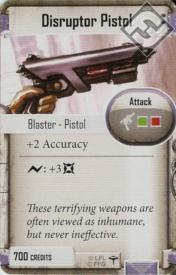UPDATE (11/3&4/2017) : "Anniversary Week" is in the books, and there's no better way to go out than with an overview and build archetype for everyone's favorite wookiee (actually, is that still true?), Gaarkhan! Thanks to all the readers who have made the last year so worth-while. I hope it's been informative and maybe even a little enjoyable, and look forward to more discoveries to come.
- "Anniversary Week" concludes by bringing this thread full-circle, with a two-part overview and build archetype for everyone's favorite melee furball HERO , Gaarkhan!
- If you missed our first post dedicated to IP CLASS DECKS and the imperial players we've been torturing with our highly-optimized melee weapons, our first write-up on Subversive Tactics is now available here !
- If you missed our return to our flagship series on CAMPAIGN MELEE WEAPONS , with another look at the Tier II Focusing Beam from "Heart of the Empire," this time on two-mod weapons (the Tier I Vibrosword and Tier II BD-1 ), it's available here !
- If you missed our launch post on CAMPAIGN RANGED WEAPONS (by popular demand), it's available here !
- If you missed our first TWO inaugural posts of our new SKIRMISH series, "Path to Destruction," you can find those here and here .
If you wandered into this thread out of curiosity (or by mistake), this thread is about numbers. More accurately, probabilities. And specifically combat probabilities: damage probabilities, surge probabilities, accuracy probabilities, defensive probabilities, condition probabilities, win probabilities, wound probabilities... basically ad nauseam probabilities. If that's not of interest to you, you prefer casual/fast/unpredictable gaming, math is overrated, etc., then you may not enjoy this. Or maybe you will...
- "The Galaxy's Fate in My Hand": Campaign Melee Weapon Series Landing Page
- "The Galaxy's Fate in My Hand": Campaign Ranged Weapon Series Landing Page
- "Path to Destruction": Skirmish Series Landing Page
- "Forces of Terror": Imperial Class Deck Series Landing Page
Here's a list of resources that I've found useful in compiling the information presented in this thread (plus a summary spiel--boy, that's a fabulous word--describing why it's so fabulous). If you've found (or created!) others, let me know and I'll update, complete with a shout-out! Unless you prefer to remain anonymous, of course...
![]()
IA Card information:
- Boardwars.eu's Imperial Assault Image DataBase : An accessible (and well-maintained) repository of IA images, for every item, card, token, etc. that I've every wondered about. The only thing I haven't found yet are the campaign books (for obvious reasons) and the faces of the IA dice... but really, that's like literally the only things I haven't found on there (so I'm certainly not complaining). Even the Agenda Decks are in there. An absolute must if you're new to the game, are looking at running your first campaign as the IP, or are looking to broaden your knowledge for advanced campaign or skirmish play. Don't miss the handy search box and "advanced search" options in the right-hand corner, either (like I did).
Probability Calculators :
- Jeff Liu's Imperial Assault Calculator : A very simple calculator that looks at raw dice stats (hit chance, average damage if hit, average surges if hit). It doesn't factor in surge abilities or other things like Pierce, Cleave, static blocks or evades, etc., but you can add range to target and defense dice. So if you just want to know what you'll be rolling on average, it'll get that information to you pretty quickly. The only limitation is that you can't add more than 2 of the same dice color to your calculation.
- AdrianTP's IA Calculator : A mid-ranged calculator. Allows input of attack dice and defense dice, but doesn't have an input for range. After you input the dice, you have two function buttons: "Roll" will actually roll the dice you selected for you, so you could use it in a pinch as a dice app if you don't have enough physical dice for your games (a nice feature). "Stats" will generate distributions for the dice you selected (attack and defense dice), showing what likelihood each outcome has of being rolled. It tracks damage, surges, and accuracy. It also tracks minimum, maximum, median, mode, and average as well, in case you wanted that info. It doesn't allow input for customized surge abilities.
- mattyellen's Imperial Assault Calculator : An advanced combat calculator, with an attribute test component. If you're like me, and are interested in mathy stuff like this, but aren't... mathematically gifted... then tools like this are great ways for even the peons like us to explore this wonderful world. Two basic functions here: an "Attack" probability calculator (broken up into melee and ranged attacks) and an "Attribute Test" calculator (plotting likely surge results). The data is wonderfully charted on graphs displaying "at least" outcome probabilities, which you can set to overlap (a nice way to see multiple probabilities for the same weapon in different configurations, different weapons with the same configuration, etc.). It doesn't calculate everything (as far as I can tell, the "Attack" calculator is limited to damage dealt, and accounts for damage, pierce, and accuracy, but not other attack stats like Cleave or Blast--stats that are notoriously difficult to calculate, since they're largely circumstantial), but the ability to add both defense dice and defense modifiers (set Blocks or Evades) and to see how those defensive modifiers affect likely outcomes more than makes up for that, in my opinion.
Further reading on probabilities:
- Two- and Three-dice comps by Emeralddays : These go back to the nascent days of IA, when everything was fresh and new. Originally featured on TeamCovenant , these have detailed breakdown of the raw roll distributions for two-dice and three-dice attack pools. I know the three-dice pool article is probably more sexy, but I'd recommend starting with the two-dice article, since it lays out his methodology and how to read the tables.






























































